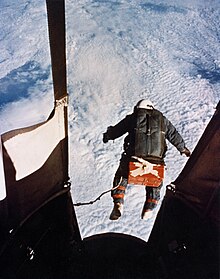Project Excelsior
| Project Excelsior | |
|---|---|

Final jump seen from Excelsior III
|
|
| Duration | 1959–1960 (three jumps) |
| Places | Stratosphere over the New Mexico desert |
| Purpose | Test of parachute for high altitude falls |
| Vehicle | Helium balloon with open gondola (the aeronaut was wearing a pressure suit) |
| Aeronaut | Joe Kittinger (Captain, USAF) |
| Records | (Last jump, 16 August 1960): Altitude: 19.47 mi (31.33 km) Speed: 614 mph (988 km/h) Duration: 13 m 45 s |
Project Excelsior was a series of parachute jumps made by Joseph Kittinger of the United States Air Force in 1959 and 1960 from helium balloons in the stratosphere. The purpose was to test the Beaupre multi-stage parachute system intended to be used by pilots ejecting from high altitude. In one of these jumps Kittinger set world records for the highest parachute jump, the longest parachute drogue fall and the fastest speed by a human through the atmosphere. The record for fastest speed by a human through the atmosphere is now held by Felix Baumgartner of the Red Bull Stratos project.
As jet planes flew higher and faster in the 1950s, the Air Force became increasingly worried about the safety of flight crews who had to eject at high altitude. Tests in Operation High Dive with dummies had shown that a body in free-fall at high altitude would often go into a flat spin at a rate of up to 200 revolutions per minute. This would be potentially fatal.
Project Excelsior was initiated in 1958 to design a parachute system that would allow a safe, controlled descent after a high-altitude ejection. Francis Beaupre, a technician at Wright-Patterson AFB, Ohio, devised a multi-stage parachute system to facilitate manned tests. This consisted of a small 6 ft (2 m) stabilizer or "drogue" parachute, designed to prevent uncontrolled spinning at high altitudes, and a 28 ft (8.5 m) main parachute that deployed at a lower altitude. The system included timers and altitude sensors that automatically deployed both parachutes at the correct points in the descent, even if the parachutist were unconscious or disabled.
To test the parachute system, staff at Wright Field built a 200 ft (61 m) high helium balloon with a capacity of nearly 3,000,000 cubic feet (85,000 m3) that could lift an open gondola and test pilot into the stratosphere. Captain Joseph Kittinger, who was test director for the project, made three ascents and test jumps. As the gondola was unpressurized, Kittinger wore a modified David Clark MC-3A partial pressure suit during these tests, plus additional layers of clothing to protect him from the extreme cold at high altitude. Together with the parachute system, this almost doubled his weight.
...
Wikipedia
